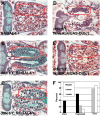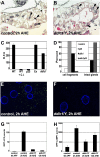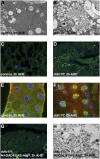Dynein light chain 1 is required for autophagy, protein clearance, and cell death in Drosophila
- PMID: 20080745
- PMCID: PMC2818958
- DOI: 10.1073/pnas.0907967107
Dynein light chain 1 is required for autophagy, protein clearance, and cell death in Drosophila
Abstract
Autophagy is a catabolic pathway that is important for turnover of long-lived proteins and organelles, and has been implicated in cell survival, tumor progression, protection from infection, neurodegeneration, and cell death. Autophagy and caspases are required for type II autophagic cell death of Drosophila larval salivary glands during development, but the mechanisms that regulate these degradation pathways are not understood. We conducted a forward genetic screen for genes that are required for salivary gland cell death, and here we describe the identification of Drosophila dynein light chain 1 (ddlc1) as a gene that is required for type II cell death. Autophagy is attenuated in ddlc1 mutants, but caspases are active in these cells. ddlc1 mutant salivary glands develop large fibrillar protein inclusions that stain positive for amyloid-specific dyes and ubiquitin. Ectopic expression of Atg1 is sufficient to induce autophagy, clear protein inclusions, and rescue degradation of ddlc1 mutant salivary glands. Furthermore, ddlc1 mutant larvae have decreased motility, and mutations in ddlc1 enhance the impairment of motility that is observed in a Drosophila model of neurodegenerative disease. Significantly, this decrease in larval motility is associated with decreased clearance of protein with polyglutamine expansion, the accumulation of p62 in neurons and muscles, and fewer synaptic boutons. These results indicate that DDLC1 is required for protein clearance by autophagy that is associated with autophagic cell death and neurodegeneration.
Conflict of interest statement
The authors declare no conflict of interest.
Figures





Similar articles
-
Growth arrest and autophagy are required for salivary gland cell degradation in Drosophila.Cell. 2007 Dec 14;131(6):1137-48. doi: 10.1016/j.cell.2007.10.048. Cell. 2007. PMID: 18083103 Free PMC article.
-
Warts is required for PI3K-regulated growth arrest, autophagy, and autophagic cell death in Drosophila.Curr Biol. 2008 Oct 14;18(19):1466-75. doi: 10.1016/j.cub.2008.08.052. Epub 2008 Sep 25. Curr Biol. 2008. PMID: 18818081 Free PMC article.
-
Activation of autophagy during cell death requires the engulfment receptor Draper.Nature. 2010 Jun 24;465(7301):1093-6. doi: 10.1038/nature09127. Nature. 2010. PMID: 20577216 Free PMC article.
-
Autophagic programmed cell death in Drosophila.Cell Death Differ. 2003 Sep;10(9):940-5. doi: 10.1038/sj.cdd.4401280. Cell Death Differ. 2003. PMID: 12934068 Review.
-
Autophagy and cell death in the fly.Methods Enzymol. 2014;545:181-99. doi: 10.1016/B978-0-12-801430-1.00008-1. Methods Enzymol. 2014. PMID: 25065891 Review.
Cited by
-
Life, death and autophagy.Nat Cell Biol. 2018 Oct;20(10):1110-1117. doi: 10.1038/s41556-018-0201-5. Epub 2018 Sep 17. Nat Cell Biol. 2018. PMID: 30224761 Free PMC article. Review.
-
A Drosophila model of FUS-related neurodegeneration reveals genetic interaction between FUS and TDP-43.Hum Mol Genet. 2011 Jul 1;20(13):2510-23. doi: 10.1093/hmg/ddr150. Epub 2011 Apr 12. Hum Mol Genet. 2011. PMID: 21487023 Free PMC article.
-
Human disease models in Drosophila melanogaster and the role of the fly in therapeutic drug discovery.Pharmacol Rev. 2011 Jun;63(2):411-36. doi: 10.1124/pr.110.003293. Epub 2011 Mar 17. Pharmacol Rev. 2011. PMID: 21415126 Free PMC article. Review.
-
Disruption in the autophagic process underlies the sensory neuropathy in dystonia musculorum mice.Autophagy. 2015;11(7):1025-36. doi: 10.1080/15548627.2015.1052207. Autophagy. 2015. PMID: 26043942 Free PMC article.
-
Kank Is an EB1 interacting protein that localises to muscle-tendon attachment sites in Drosophila.PLoS One. 2014 Sep 9;9(9):e106112. doi: 10.1371/journal.pone.0106112. eCollection 2014. PLoS One. 2014. PMID: 25203404 Free PMC article.
References
-
- Mizushima N. Autophagy: process and function. Genes Dev. 2007;21:2861–2873. - PubMed
-
- Tsukada M, Ohsumi Y. Isolation and characterization of autophagy-defective mutants of Saccharomyces cerevisiae. FEBS Lett. 1993;333:169–174. - PubMed
-
- Thumm M, et al. Isolation of autophagocytosis mutants of Saccharomyces cerevisiae. FEBS Lett. 1994;349:275–280. - PubMed
Publication types
MeSH terms
Substances
Grants and funding
LinkOut - more resources
Full Text Sources
Molecular Biology Databases

